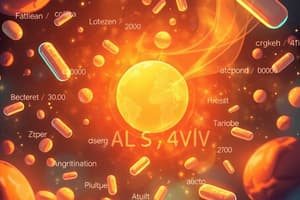Podcast
Questions and Answers
Which of the following describes a medication's generic name?
Which of the following describes a medication's generic name?
- It is the chemical name for a medication.
- It is the same as its nonproprietary name. (correct)
- It is the name under which a medication is marketed.
- It is the formal name of a particular medication.
Which of the following clients is exhibiting medication tolerance?
Which of the following clients is exhibiting medication tolerance?
- A client who continues to take a medication despite harmful effects
- A client who requires an increased dose of a medication to achieve continued therapeutic benefit (correct)
- A client who exhibits signs of withdrawal when a medication is discontinued
- A client who develops an intense craving for a medication
A nurse is caring for a client who is receiving a medication that typically causes drowsiness. While assessing the client, the nurse notes that the medication has caused the client to become hyperactive. Which of the following terms describes the client's unexpected response to the medication?
A nurse is caring for a client who is receiving a medication that typically causes drowsiness. While assessing the client, the nurse notes that the medication has caused the client to become hyperactive. Which of the following terms describes the client's unexpected response to the medication?
- Idiosyncratic effect (correct)
- Allergic response
- Toxic effect
- Synergistic effect
Which of the following represents the correct administration of the prescribed medication?
Which of the following represents the correct administration of the prescribed medication?
A nurse has a handwritten prescription that is difficult to read. Which of the following actions should the nurse take to avoid an error in medication administration?
A nurse has a handwritten prescription that is difficult to read. Which of the following actions should the nurse take to avoid an error in medication administration?
Which of the following routes of medication administration has no barriers to absorption?
Which of the following routes of medication administration has no barriers to absorption?
Which of the following actions demonstrates correct use of one of the Ten Rights of Medication Administration?
Which of the following actions demonstrates correct use of one of the Ten Rights of Medication Administration?
A client drinks 8 oz of water. Which of the following is a correct conversion of the client's intake?
A client drinks 8 oz of water. Which of the following is a correct conversion of the client's intake?
A nurse is documenting a client's response to a pain medication. Which of the following is an example of correct documentation regarding the client's response to pain?
A nurse is documenting a client's response to a pain medication. Which of the following is an example of correct documentation regarding the client's response to pain?
A nurse is preparing to administer an oral medication to a client. Which of the following actions is the nurse's priority?
A nurse is preparing to administer an oral medication to a client. Which of the following actions is the nurse's priority?
A nurse is reviewing a group of prescriptions. Which of the following should the nurse identify as an example of a complete prescription?
A nurse is reviewing a group of prescriptions. Which of the following should the nurse identify as an example of a complete prescription?
A nurse is preparing to administer several PO medications to a client. The client states they can only take one pill at a time. Which of the following actions should the nurse take?
A nurse is preparing to administer several PO medications to a client. The client states they can only take one pill at a time. Which of the following actions should the nurse take?
Flashcards are hidden until you start studying
Study Notes
Medication Names and Tolerance
- Generic names are the official, non-proprietary names of medications, which are not trademarked.
- Medication tolerance occurs when a client's response to a drug decreases over time, requiring higher doses for the same effect.
Unexpected Medication Reactions
- An unexpected hyperactive response to a medication typically known for causing drowsiness is termed idiosyncratic reaction, indicating a unique sensitivity to the drug.
Medication Administration Practices
- In cases of illegible handwritten prescriptions, the nurse should clarify the prescription with the prescriber to prevent administration errors.
- The intravenous (IV) route of medication administration has no barriers to absorption, allowing immediate drug effects.
Rights of Medication Administration
- Correct administration involves adhering to the Ten Rights of Medication Administration, ensuring the right patient receives the right medication at the right dose and time, via the right route.
- To demonstrate proper practices, a nurse should ensure the client has swallowed oral medications correctly and monitor for necessary assessments.
Measurement and Documentation
- A client consuming 8 oz of water translates to approximately 240 mL when converted.
- Accurate documentation of a client's response to pain should include details such as pain scale rating, quality of pain, and any changes after medication administration.
Client-Centered Medication Management
- If a client expresses the need to take only one pill at a time, the nurse should administer the medications sequentially rather than all at once to accommodate the client’s request.
- A complete prescription must include the patient’s name, medication name, dosage, route, frequency, and prescriber’s signature to ensure legality and clarity.
Studying That Suits You
Use AI to generate personalized quizzes and flashcards to suit your learning preferences.



